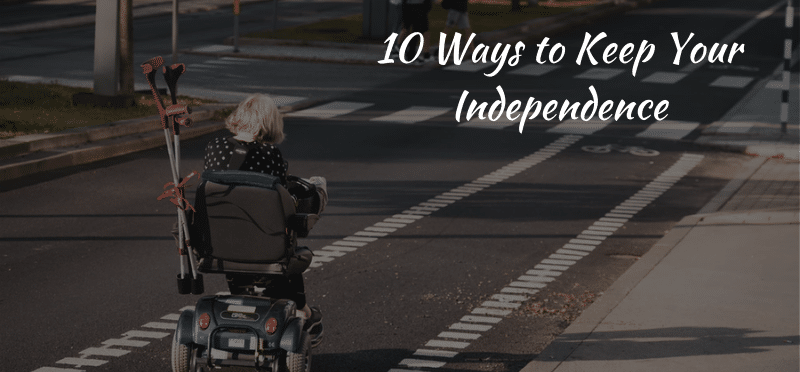
In the United States, independence is a value that we cherish. We are independent people who want to do things on our own and not have to rely on anyone else for anything. But what happens when you can’t be as independent as you used to be? What do you do if your mobility is limited or compromised in some way? How can someone with limited mobility maintain their independence?
The importance of mobility in maintaining independence is a common subject of discussion among aging adults and their caregivers, especially when health issues or environmental concerns arise. Independence is a value we hold in high esteem, but we often don’t think about how mobility can help us maintain our independence.
The following blog post will share 10 ways that those living with limited mobility can stay independent and live well!
– Use lightweight furniture that is easy to move around and store. You’d be surprised how much furniture affects your mobility and independence. While you may still be able to lift and move heavy items, the lack of mobility over time will lead to a reduced quality of life. This is why using lightweight furniture, that won’t strain your body, will help you maintain your independence. There are many lightweight furniture options available that will match any style or budget.
– Keep your living space small but functional so mobility doesn’t slow you down. Close doors behind you so that you don’t have to get up from a seated posture or bend over (e.g., the toilet). While it may be difficult to adjust to at first, but if you make sure your home is small and easy-to-navigate, you’ll never have to worry about feeling bogged down in an immobile state.
– Keep your living areas clutter free and clean so that it’s easy for you to move around. Keeping your living spaces clean and clutter-free is important for keeping up with the day to day of life. With less stuff on surfaces, including the floor, the stairs, and table and counter tops, it’s easier to move around without bumping into things or potentially slipping on any items that may be lying around.
– Modify the things in your home for safety and convenience. Use self-adhesive door and step mats to help you keep those areas safer and more slip resistant. Install grab bars in your bathroom and around your house for support when needed. Use childproof plugs/plug covers if small children, like grandkids, visit regularly. You might also change out light bulbs with motion sensors, so the lights activate when you come into the space. There are plenty of home safety options, some simple to install, some may require the help of an electrician or handyman. Just check your local home improvement store.
– If you’re living with a loved one, talk to them about how they can help you maintain independence. Discuss a way to divide up the household chores, so you can contribute despite any mobility challenges. If your loved one is doing all of the work, help them find ways that they can interact and participate in activities outside of the house. With consistant communication and teamwork, you can maintain your independence, and your loved one will still have theirs.
– Seek out resources or programs that offer mobility and self-care support if needed (e.g., Meals on Wheels, In-Home Caregivers, etc.). WIth many community programs and private companies that provide care and service to the aging community, it shouldn’t be too difficult to match services to your needs.
– Take care of your health in order to avoid any mobility related issues such as arthritis. Your body and mind are your greatest assets in this crazy world, so don’t neglect them. This includes heating healthy foods and a balanced diet, as well as choosing exercises and activities that you can do based on any limitations you have. Your doctor can help guide you on what you can do safely. To make it easier to eat healthy, plan and cook your favorite healthy dishes ahead of time and store them in the freezer. There are plenty of ways to freeze food so that you can take one out for a quick meal without any prep required – just heat up or defrost, add some sauce if needed (or even make up a little casserole), then pop it into the microwave.
– Use mobility aids, like a cane, walker, or electric scooter (space permitting) to help you get around safely. Life can be hard enough as it is, don’t make your life any harder by not using mobility aids. We realize people are often reluctant to use mobility aids, especially in public, but they can really make the difference between navigating around solo, versus needing someone beside you to help you get around. Consider putting vanity aside and using your mobility aids in the interest of your independence.
– Keep an extra set of keys near the door with labels stating what they go. This way, when someone comes over to help around the house, they won’t have to ask what each set of keys are for. This could include keys to a vehicle, a locked cabinet, a detached out-building (like a garage), or even a locked freezer. Anytime you can make it easier to help you, it improves the efficiency.
It’s never too late to start thinking about how you can retain your independence. We’ve outlined 10 things to consider if you’re looking for ways to keep your independence. Hopefully these tips were both helpful and informative. If you have any questions about how any of these points could apply to your specific situation or just want more information on our services in general, the best way is by sitting down with an expert who will review the options that are available for you and help figure out what kind of assistance would work best in each situation.
You don’t need to be on a fixed income or have someone else living in your home; there are lots of ways we can help make life easier, even if it just means having somebody around while you run errands so that you’re not alone or worrying about safety issues when traveling outside your neighborhood. For a no-cost consultation, where we’ll discuss your specific circumstances, give us a call today at (678) 494-8129 or email us at info@SilverCompanions.com.





